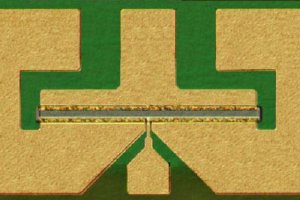Dec 8 2009
A Cornell researcher has created an extremely efficient transistor made from a material that may soon replace silicon as king of semiconductors for power applications.
 A microscopic image of a small gallium nitride-based device, which can be easily scaled up for higher current handling capability. Image: Junxia Shi
A microscopic image of a small gallium nitride-based device, which can be easily scaled up for higher current handling capability. Image: Junxia Shi
Junxia Shi, a graduate student in the laboratory of Lester Eastman, the John Given Foundation Professor of Engineering, developed the gallium nitride-based device, which could form the basis for the circuitry in products from laptops to hybrid vehicles to windmills to other power electronic systems.
The patent-pending device is a basic electrical switch made from the compound gallium nitride, a material with unique electrical properties that Eastman and colleagues have been studying for more than a decade. Research on their recent breakthrough was published July 28 in the journal Applied Physics Letters.
The new transistor's on-resistance, or measure of resistance to electric current, is 10 to 20 times lower than today's silicon-based power devices. It also has a high breakdown voltage, which is a measure of how much voltage can be applied across a material before it fails.
The key to the device lie in gallium nitride's low electrical resistance, causing less power loss to heat, and its ability to handle up to 3 million volts per centimeter without electrical failure. Silicon, a competing material, can handle only about 250,000 volts per centimeter.
At the heart of improving electronics, Eastman said, is the ability to make devices that can switch electricity from high voltage to high current, which is a measurement of electrical applicability, while minimizing power loss.
"Power has to go from A to B in a machine with a high voltage transmission line to minimize power loss," Eastman said. "Before now, there were no electronic devices that could handle both high current and the high voltage, but our device can do it."
The transistors, which were made with Cornell nanofabrication equipment, might one day power everything from hybrid electric vehicles to Navy destroyers. In fact, the U.S. Navy first funded Cornell's research into gallium nitride transistors more than 10 years ago and is a major funder of Eastman's research today.
In next-generation electrical devices, "you want to have the power that's coming out to be not much less than the power that's going in," Eastman said. "This is the best material we know of that can do this conversion without loss of energy."
Shi and Eastman have a provisional patent on their device. The New Jersey-based company Velox and Motorola spinoff Freescale have also helped fund the research, with the hope of producing the devices at an industrial scale.